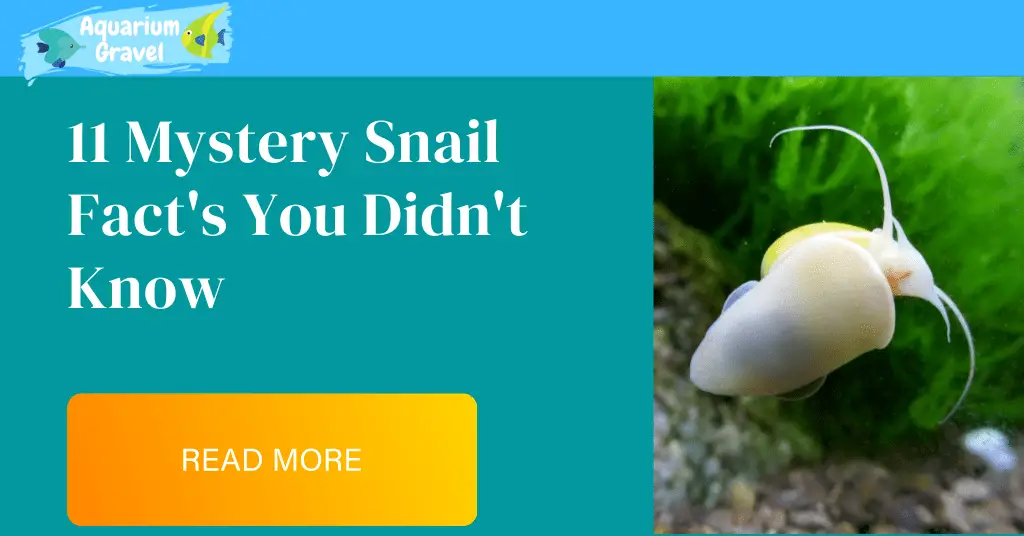Last Updated on August 19, 2022 by cmoarz
Mystery snails are fascinating creatures. While one wouldn’t think that snails would be entertaining to watch, They exhibit many fascinating traits and personality that is at times hilarious, and at others, bizarre. So here are 10 interesting mystery snail facts you didn’t know you needed to know!

1. Mystery Snail Shell Growth
Table of Contents
- 1) The shells of snails grow by only adding new material at the edges. This is called conchiolin.
- 2) The shell grows more rapidly when it is moist because the expansion and contraction are facilitated by water.
- 3) A mystery snail’s shell will have rings on them much like a tree. These rings become more pronounced during water parameter fluctuations. The ring will become larger and darker. To maintain a perfect clean-looking shell, The water perimeters should be as stable as possible.
- 4) Mystery snails need a ph of at least 7 in order for their shell to grow and remain strong. They also need access to plenty of calcium-rich foods and calcium tank supplements such as cuddle bones to keep their shell healthy.

2. Are Mystery Snails Asexual?
Mystery snails are not asexual; they aren’t hermaphroditic either and require both males and females of the same species to produce fertile egg clutches. It’s a very common misconception that mystery snails are hermaphroditic and asexual, but this isn’t true.
Snails do hold onto male genetic material for a very long period of time, and it can appear that they’ve self-fertilized when they lay eggs that are fertile. That’s where people often get confused.
Without any male genetic material, a female will still lay eggs, but these eggs are infertile and will quickly begin to rot away. Check out this article explaining how you can tell fertile and infertile eggs apart.

3. The Mystery Snail Snorkel is a Long Strange Creature all it’s own
The mystery snail snorkel is a very unique feature that they possess. It’s a long tube that goes from the opening of its shell right behind its left eye. This tube allows them to breathe without leaving the water.
If you watch very closely, You can watch expand to the surface, and actually expel water from the tube before allowing air to enter, And then the tube will fill with water again as they bring it back in.
An interesting fact about the mystery snail’s snorkel is how reckless they tend to be with it, sometimes sucking in all sorts of gunk or water.
The mystery snail snorkel can also be absurdly long on some snails, reaching 2-3x their body length. It can come as a shock the first time you see it fully extended.

4. Can Mystery Snails Flip Themselves Over
Mystery snails are completely capable of flipping themselves over if they are on their back. If the snail doesn’t seem interested or seems like it’s having issues, it could be for another reason, such as stress or being cautious. It’s most noticed when putting it in a new tank.
It does no harm to help lift her over yourself, but chances are if she isn’t interested in your help she will just roll back over.
Just be sure never to pull on a snail that’s suctioned to the glass or anything else. This can cause shell collapse in her back muscles and kill your snail. The best way to remove a snail is to gently poke at its foot until it retracts, and very carefully jiggle its shell side to side.

5. Do Mystery Snails Eat Fish Poop
Mystery snails are what are called scavengers. This means they eat any fish food that has fallen to the bottom of the tank as well as leftover uneaten food. They also will eat algae, both diatoms, and green hair algae.
But will they eat fish poop? Absolutely not. You won’t find any species of snail or bottom feeder that will eat poop. You will need to rely on plants, filters, and manual scooping with a net to deal with excess poop, sorry!

6. Where Do Mystery Snails Come From
Mystery snails originally came from East Asia, Japan, and the Philippines. There are believed to be over 700 different species of mystery snails.
They first made their way to the Americas in the early 1900s. Originally they were sourced over to America as a protein source.
They were also sold frequently as pet snails and used for fishing bait in the U.S., still are today, but only by a few fishermen.
In Europe, Mystery snails were introduced to Britain in 1855 and were used to feed animals as a cheap, rapid breeding source of protein.

7. Can Mystery Snails Live in Cold Water
Mystery snails are not tropical creatures. They can survive in water temperatures as low as 45°F, but prefer temperatures right around the 70s to high 50s for optimal growth and health.
In general, Anything less than the low 70’s will have them go into hibernation. Coldwater just above hibernation levels will slow their growth and extend their life dramatically, however, their activity will drop to nearly zero.

8. How Often Do Mystery Snails Mate
Mystery snails do 3 things, They eat, they poop, and they mate. In fact, They mate a lot! These frisky snails will attempt to mount any snail they see.
The female mystery snail can hold enough of the male’s genetic material to fertilize several clutches of eggs.
If you have a male and a female mystery snail, it’s guaranteed you’re going to see the male on top of the female’s right shoulder more often than you don’t.

9. Mystery Snail Shell Changing Color
You may have noticed your mystery snail shell changing color. Mystery snail shells will change colors rapidly as they age. Young snails tend to be much more colorful than older snails, and the color range of a single snail is diverse.
Their shell may also change color drastically based on the water parameters in your tank. If their shell color has changed dramatically, don’t panic and assume it’s dead or dying.
Very rarely, Sometimes a snail will develop 3 or even more colors at once. Sometimes it’s a sign of bad water perimeters, and the dominant color will eventually take back over once the water is cleaned up.

10. Mystery Snail Shell Erosion
Mystery snails shells are supposed to be hard and strong. If the shell is soft, brittle, and seems like it’s eroding, that means the water is too acidic and the hardness needs to be brought up.
Snails require an abundance of calcium and calcium-rich hard water to have thriving hard healthy shells.
In fact, Your mystery snail is always growing a new shell over the old. If water parameters swing or change often, You can see the differences in erosion like tree rings on the shell. This can also affect coloration.

11. Mystery Snails Like To Play!
Did you know mystery snails like to have a bit of fun from time to time? It’s true! It’s also very fascinating to watch. Sometimes they will float around, lazily carried by the currents, And other times they will use your airstone bubbler to fly up high and parachute back to the bottom of the tank.
These snails aren’t as lazy as a lot of people may think, and they enjoy having a good time once and a while.
Check out our identification guide What does snail eggs look like To help identify more snail eggs
About
Owner of AquariumGravel.com and also owner of actual Aquarium Gravel believe it or not! ;). Setting up beautiful aquarium sceneries and habitats since I was very young. Enjoy!
- Web |
- More Posts(290)

